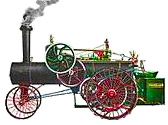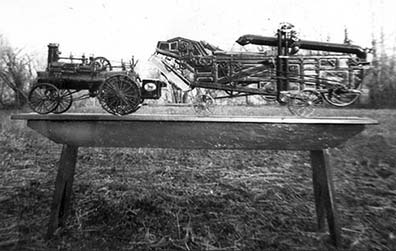Man Constructs Miniature Threshing Outfit

Oldest Working Steam Engine and Model
Mendon Man Cuts Dream Into Replica, Acquired Old Engine, Then Constructed Model of It.
Forty-four years ago a steam-driven mechanical monster that had the power of ten horses came to Mendon. Skeptical folks feared an explosion as the engine hissed and snorted; others marveled as the machine replaced sore-shouldered horses on "that horse-killing thrasher."
L.K. Wood, then only a youth, admired the steam engine and his admiration finally grew into an obsession to own it. He finally did acquirer it, fulfilling a dream of many years, and today Mr. Wood claims to possess the oldest operating steam engine in Utah. He has kept it carefully, attending its needs as if it were a pampered pet. But this story does not end there. Mr. Wood, who is a carpenter, tinkers in his blacksmith shop as a hobby. He decided to do something creative with his hobby, so he created a miniature replica of his beloved engine.
The model engine exact in every detail, is nineteen and one half inches long and eight and one half inches wide; it stands eleven inches high and weighs twenty-six pounds. It required sixty days to build, at the rate of eight hours a day. Most of the parts were constructed by hand and the rest of them were fashioned on a home-made lathe. The little model will generate eighty pounds of steam from a coal burner, which is lighted by a torch; it runs with twenty pounds of steam forward and backward and utilizes forty pounds in traction.1
Constructs Miniature Threshing Outfit
Mendon Resident Constructs Miniature Threshing Outfit.
A miniature traction engine and "agitator separator," which actually threshes grain under steam power, has been constructed from scrap wood and metal by L.K. Wood of Mendon, Utah. In constructing what he claims is the smallest working threshing rig in existence, Mr. Wood satisfied a lifelong interest in machinery which began when he followed the crews from field to field during threshing time as a boy.
The miniatures were constructed to a one-ninth scale, patterned after the Russell traction engine and the Case separator, when they were the "last word" in grain harvesters, fifty years ago. If they serve no other purpose, their maker points out, the models may be valuable in preserving one stage of the historic development of the implements.
The entire threshing outfit weighs only forty-one pounds, twenty-seven and a half for the power engine and thirteen and a half for the separator. The engine is nineteen and one-half inches long, eight and one-half inches wide and eleven inches high. The separate is twenty-three and one-half inches in length over all, not including the straw carrier, nine and one-half inches in width and eleven in height, not including the carrier.
Mr. Wood selected his own "Old Betsy" 1892 model as a model for the traction. After working sixty, eight-hour days of spare time and time borrowed from other work, he tested the miniature at eighty pounds steam pressure. The main parts are wood patterns cast in brass and the flues are brake tubing from auto wreckage, but in good conditions.

After completing the engine
the craftsman explains, I started on the separator, so depriving myself of every other pastime and infringing on my regular work. I spent fifty-three days at eight hours per day to complete the Case agitator model.
More bearings and more shafts made the latter a more technical job. The wood work required carving to one-sixteenth inch thickness. Nails had to be drilled to make cylinder heads. All of the material was scrap from a junk pile, but trimmed exactly to scale. Mr. Wood then painted the two units exactly as in the original models.
That satisfaction of seeing it run by steam and actually thresh wheat, other grains and seed, just like the big one, is well worth my tedious efforts,
he concludes.2
Tools Required to Build Steam Models
The main things you need for model making is a good drill press and lathe. The hand tools consist of hack saw blades and files mostly. I use up dozens of them making models. The drill bits I use are mostly high speed from number eighty, which is finer than a needle up to five-eights of an inch. A set of small dies from one-sixteenth up to one-quarter of an inch also a set of machine screw dies and taps. A set of Crescent wrenches from four inch to ten inches. Pipe wrenches from four inches up to ten inches. A set of socket wrenches from one-eighth to one-half inch openings. A good steel rule, a steel square, a steel tape, calipers both inside and out and a depth measure.

You want good eyes; I had to use a magnifying glass on some parts. You must have unlimited patience and stay with it. Got to be accurate, no guess work. I am building a five horsepower Russell model or just one-half the size of my old Russell ten horsepower. The boiler will be thirteen and one-half inch outside and about six feet long. Two inch flues. I use two inch for better draft and less liable to choke up with soot.
It will be electric welded inside and out. I use three-sixteenth inch boilerplate. I have the Gidding patent reverse gear nearly made, my levers and some brackets. I should of made the boiler first but I've been snowed in so I could not hardly get off the lot. I'm going to Ogden next week and get my rolling and shearing done at the Ogden Iron Works. The fine drills and dies can be bought from Ballco Electric Tool and Supply Company, 605 West, Washington Boulevard, Chicago Illinois.3
Notes…
L.K. Wood took this tiny creation of his, to the 1939 World Far in New York City. Along the way he stopped over in Massillon, Ohio, to view and visit the Russell & Company main office and production factory. He saw the old ledger that contained the build date and shipping destination of "Old Betsy." He shared his one-ninth scale Russell traction engine, modeled exactly after the engine he now owned, and they had originally built. The model was constructed in the 1933 to early 1934 time period.
This same model would be displayed in the Utah State Capitol building for the 1947 centennial and on for about fifteen years. We drove down to Salt Lake City to view it a few times, as many of the Mendon folks did.I have heard that there was another one that was in the Smithsonian museum, for a time? But have no proof of this. L.K. Wood's fame at the time was quite well known in threshing circles. He was invited by the Ford Motor Company to display and attend the National Thresher Men's Convention at Dearborn, Michigan in July of 1945 and had many visitors from far and wide at his home here in Mendon, Utah. L.K. was smart, kind and gentle, a devoted member of the church. He was also involved in local drama, the first Mendon Historical Society and had chage of the building and dedication of the Mendon Pioneer marker, in 1957.
He almost single-handedly financed the Mendon Sunday school with the procedes of the ward feeding the throngs of folks who came to Mendon each year. From 1950 to 1966 he put on sixteen threshing bees here. Several thousand visitors came each year, Mendon's first traffic jam was due to his threshing bee. May Day is very important to the people of Mendon, but L.K. Wood's Threshing Bee was much bigger. My aunt, Veda Sorensen once noted that she registered 4,000 people for the threshing bee. This was just the outside visitors to Mendon for the most part, so it was quite a big production for a long time.
- Oldest Working Steam Engine and Model, Salt Lake Tribune, May 31st, 1936, page 52.
- Mendon Resident Constructs Miniature Threshing Outfit, Salt Lake Tribune, April 7th, 1937, page 6.
- Tools Required to Build Steam Models, L.K. Wood, Personal Correspondence.